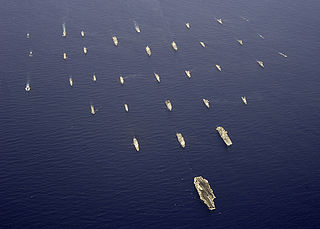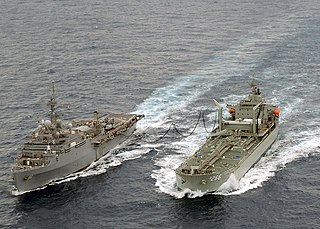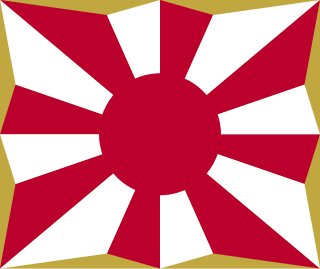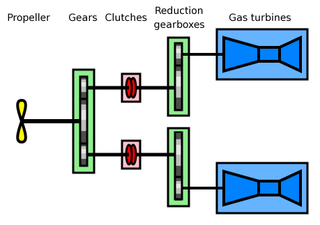
A blue-water navy is a maritime force capable of operating globally, essentially across the deep waters of open oceans. While definitions of what actually constitutes such a force vary, there is a requirement for the ability to exercise sea control at wide ranges.

A replenishment oiler or replenishment tanker is a naval auxiliary ship with fuel tanks and dry cargo holds which can supply both fuel and dry stores during underway replenishment (UNREP) at sea. Many countries have used replenishment oilers.

The Japan Maritime Self-Defense Force, JMSDF, also referred to as the Japanese Navy, is the maritime warfare branch of the Japan Self-Defense Forces, tasked with the naval defense of Japan. It is the de facto navy of Japan and was formed following the dissolution of the Imperial Japanese Navy (IJN) after World War II. The JMSDF has a fleet of 154 ships and 346 aircraft and consists of approximately 45,800 personnel. Its main tasks are to maintain control of the nation's sea lanes and to patrol territorial waters. It also participates in UN-led peacekeeping operations (PKOs) and Maritime Interdiction Operations (MIOs).

The Japan Self-Defense Forces, JSDF, also referred to as the Self-Defense Forces (SDF), Japan Defense Forces (JDF), or the Japanese Armed Forces, are the unified military forces of Japan that were established in 1954, and are controlled by the Ministry of Defense. The JSDF ranked as the world's fourth most-powerful military in conventional capabilities in a Credit Suisse report in 2015 and it has the world's eighth-largest military budget. In recent years they have been engaged in international peacekeeping operations including UN peacekeeping.

The Japan Ground Self-Defense Force, JGSDF, also referred to as the Japanese Army, is the land-warfare branch of the Japan Self-Defense Forces and the de facto army of Japan. Created on July 1, 1954, it is the largest of the three services branches.

Combined gas turbine and gas turbine (COGAG) is a type of propulsion system for ships using two gas turbines connected to a single propeller shaft. A gearbox and clutches allow either of the turbines to drive the shaft or both of them combined.

The Tachikaze-class destroyer is a second generation guided missile destroyer class, formerly in service with the Japan Maritime Self-Defense Force (JMSDF). The ships of this class have had successive improvements after their completion, especially to their C4I systems. These air-defense warships are the natural successor to the first generation air-defense ship, the Amatsukaze-class destroyer, and they were in turn, followed by newer air-defense ships, the Hatakaze class.

Green-water navy is terminology created to describe a naval force that is designed to operate in its nation's littoral zones and has the competency to operate in the open oceans of its surrounding region. It is a relatively new term, and has been created to better distinguish, and add nuance, between two long-standing descriptors: blue-water navy and brown-water navy.

JDS Wakaba was the former Imperial Japanese Navy ship Nashi, a Tachibana-class destroyer. Nashi was sunk in July 1945, but salvaged in 1954 and refitted to join the Japan Maritime Self-Defense Force in 1956 as Wakaba, later being utilised as a radar trials ship.

JS Kirishima (DDG-174) is a Kongō-class guided missile destroyer in the Japan Maritime Self-Defense Force (JMSDF). Kirishima was named for Mount Kirishima.

JMSDF Tateyama Air Base is a military aerodrome of the Japan Maritime Self-Defense Force. It is located outside the city of Tateyama in Chiba Prefecture, Japan, at the southern tip of the Bōsō Peninsula

JS Ōnami (DD-111) is the second vessel of the Takanami-class destroyers of the Japan Maritime Self-Defense Force (JMSDF).
Destroyer escort is the US Navy classification for a smaller, lightly armed warship designed to be used to escort convoys of merchant marine ships.

JS Suzunami (すずなみ) is the fifth vessel of the Takanami-class destroyers of the Japan Maritime Self-Defense Force (JMSDF).
Four Japanese destroyers have been named Ikazuchi:
Four naval vessels of Japan have been named Asashio:
Several Japanese ships have been named Tokiwa:












